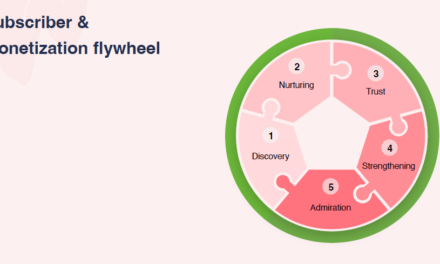
APRIL 7, 2023
5 things to do
As Q2 begins, you would do well to revisit your Q1 numbers – metrics, finances, and time. They can give you a wealth of information to help your content business perform even better from April to December.
1. Revisit your strategic objectives: Pull out your business objectives as a reminder of what metrics you need to know. (If you don’t have goals, create them before you move on to the next thing to do.)
Remember, goals have a general objective, a measurable number, and a timeline to achieve them. For example, your goal might be to grow newsletter subscribers (general objective) by 10% (measurable number) in the first quarter of the year (timeline).
You have to know your goals before your data is useful. “The companies that are going to win are the ones who are using data, not guessing,” Neil Hoyne, Google’s chief measurement strategist, once said at a Wharton symposium.
2. Update metrics report: If you don’t have a spreadsheet or other dashboard to track your numbers, create one. Update it at least quarterly.
Fortunately – and unfortunately – you have access to a lot of numbers, from your website to your other distribution platforms and tools. Instead of listing every metric available, list only the data categories most relevant to your primary business channel(s) and your objectives.
Start with the obvious, measurable elements. In Google Analytics, these include page views, time on site, bounce rate, etc. In social media, these are followers, impressions, likes, etc. In newsletters, it’s open rates, click rates, etc.
3. Listen to what your audience tells you: Your metrics act as a translator of your audience’s voice – what they’re interested in, what they don’t care about, etc.
Look at the data for patterns or extreme highs or lows. Scrutinize other potentially related metrics or delve deeper into the causes of an anomaly. Sometimes, it helps to turn the spreadsheet numbers into data visualizations to see trends more clearly.
For example, if your goal is to build brand awareness by doubling your audience on a social platform, look for growth spikes and identify the posts or actions that correspond to that time. Was there a singular topic or area of focus? Did you use particular hashtags or mentions that drove engagement? What were the comments focused on? Look for opportunities to replicate that type of content to see if that has the same effect.
Or perhaps you added a video version of your podcast. Download and viewership data will help you understand if the current audience is interested in both options. If not, is it because they don’t like video, or is it because they aren’t aware of the new video option? To figure that out, you can increase your marketing of the video format in the next quarter to better understand what the Q1 data meant.
4. Examine your finances: Even if your revenue isn’t robust, you still need to pay attention to the money coming in and the money going out. That manifests itself in a profit-and-loss statement where you document your expenses and revenue. (Here’s some help to create a P&L statement.)
Though you spent the money and invoiced to collect the revenue throughout the quarter, a close review of the P&L statement allows you to better understand the big picture. Did you overspend in some categories? Could you cut back, or should you adjust the budget going forward? Did revenue meet expectations? If not, do you need to reassess your marketing? Price points?
How healthy is your business emergency fund? Strive to include at least six months of expenses that you incur no matter how much (or how little) revenue is coming in. These can be things like hosting services, content production costs, software subscriptions, etc., that you need to create.
If you pay yourself from the business revenue, reassess your personal finance numbers, too. For example, have you saved enough money to pay income taxes as well as the self-employment tax rate for Medicare and Social Security? (Self-employed people must pay the 12.4% Medicare and Social Security taxes (up to $142.8K) in the United States.) How is your personal emergency fund doing? (To calculate how much money should be in your emergency fund, NerdWallet has an emergency fund calculator.)
5. Assess your time: You likely spend a lot of hours working on your content business. But how efficiently and effectively do you use that time? To consider that, you first must know how much time you spend and what you do during those hours. That requires tracking your time. (I use Toggl’s free version, but lots of options exist – including old-fashioned pen and paper.) If you didn’t track your time in Q1, estimate it by reviewing your calendar.
Now, you can evaluate how much time you spend on every aspect of the business – content creation, distribution, marketing, business operations, etc. Is that mix delivering what you want? Do you spend an inordinate amount of time on a task because of your inexperience? Maybe you could outsource that responsibility? Are you focusing too much on content creation and not enough on marketing?
To find the answers – and determine what to do next – you should analyze your time at the same time you evaluate your audience data and financial metrics. All three sets of numbers allow you to make fully informed decisions.
– Ann Gynn
Resources:
- How To Set Goals as a Content Entrepreneur
- Use Data To Drive Your Content Strategy
- What Does Your Audience Think of Your Website?
- Personal Finance for Content Entrepreneurs
- Content Plans That Work for You and Your Audience
- Content Calendar [Template]
- How To Make the Most of Your Content Business Time
Want to guest blog for The Tilt? Here are the guidelines. Have a question? Ask Ann.
sponsored content
Use AI to boost engagement on Tiktok
Want to step up your game on Tiktok? Our AI-powered assistant can tell you how to get more interactions from your fans.
Grandstage is giving only 100 creators beta access to our AI assistant for social content creation.
No more fussing with analytics to understand what works and scrolling your feed for trends. Sign up today for personalized recommendations on trends to follow, content to create, and fan engagement.
5 things from the tilt
- In 75 seconds, Digiday shares how to price a subscription product.
- Subscribe today to For The Interested, a newsletter that shows creative entrepreneurs how to produce, promote, and profit from their creations based on how others have successfully done it.*
- Listen to Joe and Robert discuss 10 proven ways to build an audience. [This Old Marketing podcast]
- Joe talks about three methods to break through all the content clutter out there. (Content Inc. podcast)
- CEX Speaker Spotlight: Mega-Successful YouTuber Roberto Blake Says You Should Do These 5 Things
*The Tilt receives a small commission if readers (at no additional cost) make a purchase using this link.
sponsored content
Web3 unlocks enormous opportunities for artists & creators looking to monetize their work and provide better experiences for their audience. But this space is confusing, we know. That’s why you need to read Web3 Academy’s Free newsletter.
Stay on the forefront of the next iteration of the internet and learn how to capitalize on the opportunity.
Subscribe for FREE to Web3 Academy.
5 things to know
Money
-
Read aloud: Advertisers at a podcast business summit say substantial interest remains in host-read embedded ads. Even with the added cost of the host’s voice, it’s still affordable compared to other ad channels. (Sounds Profitable)
Tilt Take: Knowing what advertisers are interested in can help you develop better promotions and pitches. -
Twitch grab: Twitch is experimenting with streamer-read ads, sub codes (brands buy and give codes off the platform to viewers), sponsored gift subs (brands buy and give subs in chats), and sponsored sub discounts (brands sponsor discounts for subscribers so streamers receive regular sub payouts). (tubefilter)
Tilt Take: Twitch’s amped up its money game, expanding revenue options to boost its business. We wonder how that will affect the creators.
Audiences
-
Smiley face: YouTube livestreamers now can let their viewers react with emojis in real time. While reactions are anonymous, they may help highlight top moments to increase replay engagement and help creators understand what viewers are most interested in. (Social Media Today)
Tilt Take: We’re surprised YouTube didn’t offer this option until now.
Tech and Tools
-
Hype up: Penny Pass turned into Pico, which now rebrands itself as Hype. The CRM for creators continues to raise more money and recently expanded its linktree game with Hype Kits, landing-page templates for creators. (Tech Crunch)
Tilt Take: Interest remains in businesses supporting the mega creator economy.
And Finally
-
Tense up: Creating content requires great verbs. And great verbs require the right tense. Past tense works well for storytelling and creating a sense of nostalgia. Present tense brings immediacy and urgency. Future tense works best for describing plans and making predictions. (Wattpad Creators)
Tilt Take: OK, this isn’t really news, but we’re all for using the right tense to get across your story.
Be Part of the TILT Nation with Our New Rewards Program
Share The Tilt Newsletter with other content creators and get exclusive swag and more.
Your unique link: https://www.thetilt.com?rh_ref=[RH CODE GOES HERE]
Track your referrals here.
Or share via Twitter, LinkedIn, Facebook, or email.
*Please note the rewards program is only available to US readers at this time. The Tilt reserves the right to reject referrals at their discretion.
the tilt team
Your team for this issue: Joe Pulizzi, Pam Pulizzi, Ann Gynn, Laura Kozak, Marc Maxhimer, and Dave Anthony.
Get more of the Full Tilt stories on TheTilt.com.
Know a content creator who’s going full tilt? DM us or email [email protected]
Want to advertise on The Tilt? Go here.
Or email us at [email protected]
Interested in the tools we use? Check out our Tilt Tech Stack here.
Was this email forwarded to you? Get your own sub here.
Copyright ©2023 Tilt Media LLC All rights reserved.
Update your preferences | Unsubscribe | 17040 Amber Drive, Cleveland, OH 44111





